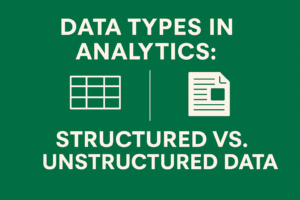Data analytics is no longer a luxury for enterprise giants—it’s a fundamental pillar of everyday business strategy across industries. Whether you’re running a retail store, a healthcare clinic, or a manufacturing plant, data analytics can unlock insights that boost efficiency, drive sales, reduce costs, and elevate customer satisfaction. In this blog, we explore real-world applications of data analytics and how businesses are leveraging it to make data-driven decisions.
1. Customer Behavior Analysis
📈 Example: E-commerce Personalization
Use case: Online retailers like Amazon analyze millions of user interactions to personalize product recommendations.
Technique:
- Clickstream Analysis and Collaborative Filtering using machine learning models such as k-NN or matrix factorization.
- Real-time data pipelines (e.g., with Apache Kafka + Spark) analyze customer sessions for on-the-fly recommendations.
Impact: Increased conversion rates and customer retention by delivering a personalized shopping experience.
2. Operational Efficiency
🏭 Example: Manufacturing Predictive Maintenance
Use case: Predictive analytics is used to anticipate machine failures before they happen.
Technique:
- IoT sensor data is collected from machinery and fed into time-series forecasting models (like ARIMA, LSTM).
- Anomalies are flagged using outlier detection or unsupervised learning (e.g., Isolation Forests).
Impact: Reduces unplanned downtime, extends asset life, and lowers maintenance costs.
3. Supply Chain Optimization
🚚 Example: Inventory Management in Retail
Use case: Retailers use analytics to forecast product demand and optimize stock levels.
Technique:
- Regression models (e.g., XGBoost) for demand forecasting.
- Integration with ERP systems for dynamic stock reordering.
Impact: Avoids overstocking/understocking, reduces warehousing costs, and improves cash flow.
4. Marketing Campaign Performance
📣 Example: Multi-Channel Attribution in Digital Marketing
Use case: Marketers measure ROI across various channels (email, social, paid ads).
Technique:
- Attribution models (e.g., Markov Chains, Shapley Value).
- Visualization via BI tools like Tableau or Power BI.
Impact: Identifies high-performing channels, enabling better budget allocation and targeting.
5. Risk Management and Fraud Detection
💳 Example: Financial Institutions Monitoring Transactions
Use case: Banks monitor real-time transactions for fraud.
Technique:
- Real-time analytics using stream processing (e.g., Apache Flink).
- Anomaly detection using supervised (Random Forest) and unsupervised (Autoencoders) models.
Impact: Reduces financial loss and builds customer trust.
6. Human Resources Analytics
🧑💼 Example: Employee Retention Modeling
Use case: Companies predict which employees are at risk of leaving.
Technique:
- Logistic regression or survival analysis on features like tenure, performance, and engagement scores.
- Dashboards tracking workforce KPIs.
Impact: Proactive engagement and talent retention strategies, reducing hiring costs.
7. Customer Support and Sentiment Analysis
🤖 Example: Chatbot Feedback and Review Mining
Use case: Analyzing support tickets and customer feedback to improve service.
Technique:
- NLP techniques (sentiment analysis using BERT, keyword extraction).
- Clustering support issues to identify common pain points.
Impact: Shorter resolution times, improved customer satisfaction, and informed product development.
8. Real Estate and Location Intelligence
🏢 Example: Site Selection for Expansion
Use case: Retail chains analyze demographic and traffic data for opening new stores.
Technique:
- GIS data combined with clustering algorithms (e.g., DBSCAN).
- Heatmaps generated using tools like QGIS or Python (folium, geopandas).
Impact: Data-informed site selection leading to better footfall and revenue projections.
Final Thoughts
From strategic planning to day-to-day decision-making, data analytics is transforming how businesses operate. The success stories across domains underscore the value of turning raw data into actionable insights. Organizations that invest in the right tools, talent, and data culture will not only gain a competitive edge—but will redefine what’s possible in their industry.
🛠️ Tech Stack Highlights
- Languages: Python, R, SQL
- Tools: Power BI, Tableau, Looker, Google Analytics
- Frameworks: scikit-learn, TensorFlow, PySpark
- Platforms: AWS, Azure, GCP (BigQuery, Redshift)
- Pipelines: Airflow, dbt, Kafka
